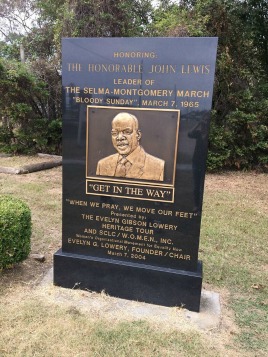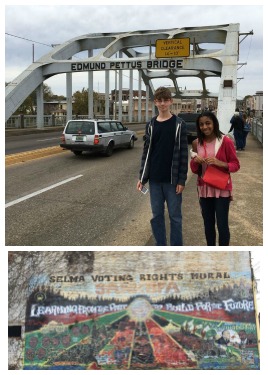A Town of Yesterday, A Town of Today
by Olivia Novak
I walked through the streets of Selma, slightly behind the rest of the group due to my stopping every 10 feet to read one of the plaques, signs, or memorials that were part of the Civil Rights memorial walk. I remembered a lot of these sights from the movie Selma, and I felt as if we were seeing Selma as it was 50 years ago. We had watched the movie the day before and many of us were really affected by this movie that showed us the scary place that was Selma during the Civil Rights Movement.
After watching the movie and seeing all the terrible things that happened in Selma, and then being in the city where it all happened, I felt as if we were piecing together the pieces of a puzzle—a puzzle that was hard to think about, but one that we learned so much from. Selma the movie brought me to tears, and as we saw all these sights where so many people had suffered and died, I was very close to tears yet again.
 I kept thinking back to an article that had been in a coffee shop we had stopped at earlier that day for a "potty break" (that soon became a coffee break) that talked about the woman who owns the Coffee Shoppe. Growing up in Selma she often went to the restaurant that used to be in that building.
I kept thinking back to an article that had been in a coffee shop we had stopped at earlier that day for a "potty break" (that soon became a coffee break) that talked about the woman who owns the Coffee Shoppe. Growing up in Selma she often went to the restaurant that used to be in that building.
As a black girl, she never even stepped foot in the restaurant, she always had to get food from the back kitchen door and eat outside. Now, like 40 years later, she owns the building. I was starting to really understand how much the Civil Rights Movement changed things and really how it wasn't that long ago. There are a ton of people today who lived during that time when events like Bloody Sunday and the March on Washington happened.
There was a very solemn air around our group, mostly around the people at the back who were really stopping to appreciate everything. As I read some of the signs, out of the corner of my eye I could see people playing around, and I kept wondering if those people were making the connection between the movie and the city. I wondered if the people who lived there even thought about the history of their town. It seemed to me at least some people hadn't forgotten due to the beautiful murals commemorating the Civil Rights Movement and the people who helped it happen on walls throughout Selma.
As a grand finale to this walk we crossed the Edmund Pettus Bridge. I felt sad walking over that bridge and thinking about how I could freely walk back and forth over the bridge, but there were people years ago who crossed and were met on the other side by state troopers and police. It also kind of gave me the heebie-jeebies to be there where so many people suffered. It's like the feeling when you walk through a battleground.
 It really was a battleground of the Civil Rights Movement. It was a battleground for peaceful activists who wanted nothing more than to make a better world for themselves and their people, but were met with guns, clubs, and firehoses. It just baffled me to think about how that "peaceful protest" so easily became a bloodbath. We were studying a peaceful movement, but somehow we were having to really look to find the peace.
It really was a battleground of the Civil Rights Movement. It was a battleground for peaceful activists who wanted nothing more than to make a better world for themselves and their people, but were met with guns, clubs, and firehoses. It just baffled me to think about how that "peaceful protest" so easily became a bloodbath. We were studying a peaceful movement, but somehow we were having to really look to find the peace.
As we walked back over I remembered the words of a man we had talked to earlier that day—words that helped to change my perspective on this city we were visiting and also, in a way, to see the events we were studying that happened in Selma as a more real thing, rather that just stories or facts in a book. "When you go over the bridge it's important to remember the people who fought on that spot 50 years ago, but as you come back, remember the people who live in Selma now, people who aren't perfect. Please remember that Selma is more than just a town of the Civil Rights Movement, it's a town of today".